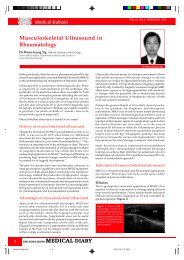MEDICAL DIARY - The Federation of Medical Societies of Hong Kong
MEDICAL DIARY - The Federation of Medical Societies of Hong Kong
MEDICAL DIARY - The Federation of Medical Societies of Hong Kong
You also want an ePaper? Increase the reach of your titles
YUMPU automatically turns print PDFs into web optimized ePapers that Google loves.
32<br />
<strong>Medical</strong> Bulletin<br />
Role <strong>of</strong> Trans Fatty Acids<br />
Consumption <strong>of</strong> dietary Trans fatty acids is associated<br />
with a deleterious increase in small, dense low-density<br />
lipoprotein (LDL) cholesterol particles. Dietary Trans<br />
fatty acids are formed during the process <strong>of</strong><br />
hydrogenating vegetable oil and should be reduced in<br />
our dietary component.<br />
Beyond LDL-C Reduction<br />
<strong>The</strong> main atheroprotective mechanism <strong>of</strong> HDL is<br />
related to its ability to facilitate the reverse cholesterol<br />
transport pathway, by which excess cholesterol from<br />
peripheral cells, such as macrophages, in the vessel wall<br />
is transported to the liver for excretion. HDL has been<br />
shown to prevent endothelial dysfunction; it inhibits the<br />
expression <strong>of</strong> adhesion proteins by endothelial cells,<br />
which mediate the initial attachment and infiltration <strong>of</strong><br />
monocytes into early plaques. HDL also has favourable<br />
effects on the vasomotor tone <strong>of</strong> vessels, by promoting<br />
the nitric oxide production <strong>of</strong> endothelial cells, which<br />
increases vasodilatation and suppresses smooth muscle<br />
cell proliferation in plaques. HDL reduces platelet<br />
activation and promotes fibrinolysis and thus may<br />
inhibit the formation <strong>of</strong> a thrombus over ruptured<br />
plaques. A combined approach <strong>of</strong> simultaneously<br />
lowering LDL-C and raising HDL may be more<br />
effective in reducing cardiovascular events than only<br />
lowering LDL-C.<br />
Other than pharmacological therapy, exercise is useful<br />
for increasing the HDL level. Currently, the most<br />
effective drug for increasing HDL is niacin but its use<br />
has been limited because <strong>of</strong> side effects. Cholesteryl<br />
ester transfer protein inhibitors are effective to elevate<br />
HDL but in the Investigation <strong>of</strong> lipid Level<br />
management to understand its impact in atherosclerotic<br />
events trial (ILLUMINATE) has demonstrated its<br />
negative effect. <strong>The</strong> trial is terminated early because it<br />
had recorded 82 deaths in the patients taking<br />
torcetrapib-atorvastatin against 51 in patients taking<br />
atorvastatin alone. In addition to the increase in<br />
mortality, the rates <strong>of</strong> myocardial infarction (MI),<br />
revascularisation, angina, and heart failure were higher<br />
in the torcetrapib-atorvastatin arm.<br />
Other HDL Replacement <strong>The</strong>rapy<br />
Apo-lipoprotein A-I is one <strong>of</strong> the protein components <strong>of</strong><br />
HDL and is a natural choice for therapeutic HDL<br />
replacement. APOA-IMilano (ETC-216), a synthetic<br />
Apo-lipoprotein AI has been developed as a therapeutic<br />
agent for HDL replacement. <strong>The</strong> first clinical study <strong>of</strong><br />
the effect <strong>of</strong> ETC-216 in humans was assessed by<br />
intravascular ultrasound on patients with acute<br />
coronary syndrome. 5 In this trial, 57 patients were given<br />
weekly infusions <strong>of</strong> ETC-216 at 15 and 45 mg/kg or<br />
placebo for 5 weeks and were assessed by intravascular<br />
ultrasound at baseline and after the 5-week treatment<br />
period. <strong>The</strong> average decrease in plaque volume for the<br />
ETC-216 treatment group was 4.2% compared with<br />
baseline, whereas there was a slight increase in plaque<br />
volume <strong>of</strong> 0.14% in the placebo group, which was<br />
VOL.14 NO.1 JANUARY 2009<br />
statistically significantly different from the treatment<br />
group. Other secondary measures, such as absolute<br />
change in plaque volume and maximum atheroma<br />
thickness, also showed a favourable statistically<br />
significant improvement. Based on the analysis <strong>of</strong> the<br />
position <strong>of</strong> the external elastic membrane, atheroma<br />
volume in the most diseased segments was reduced by<br />
10.9% on average after treatment with ETC-216.<br />
However HDL replacement is still not available for our<br />
daily management <strong>of</strong> patients.<br />
In summary among those at risk <strong>of</strong> cardiovascular<br />
disease, lipid lowering with statins confers similar<br />
cardiovascular risk reduction across all ranges <strong>of</strong><br />
baseline LDL-C and clinical benefit is related to the<br />
absolute reduction in LDL-C. Level <strong>of</strong> < 2.0 mmol/L<br />
should be the target in patients having cardiovascular<br />
risk. Exercise as a means for HDL raising should be<br />
advocated to our patients.<br />
References<br />
1.<br />
2.<br />
3.<br />
4.<br />
5<br />
MRC/BHF Heart Protection Study <strong>of</strong> cholesterol-lowering therapy<br />
and <strong>of</strong> antioxidant vitamin supplementation in a wide range <strong>of</strong><br />
patients at increased risk <strong>of</strong> coronary heart disease death: early<br />
safety and efficacy experience. Eur Heart J. 1999; 20:725-741.<br />
Management <strong>of</strong> Elevated Cholesterol in the Primary Prevention<br />
Group <strong>of</strong> Adult Japanese (MEGA) Study Group. Design and<br />
baseline characteristics <strong>of</strong> a study <strong>of</strong> primary prevention <strong>of</strong><br />
coronary events with pravastatin among Japanese with mildly<br />
elevated cholesterol levels. Circulation 2004; 68:860-867.<br />
Scirica BM, Morrow DA, Cannon CP et al. Intensive statin therapy<br />
and the risk <strong>of</strong> hospitalization for heart failure after an acute<br />
coronary syndrome in the PROVE IT-TIMI 22 study. J Am Coll<br />
Cardiol 2006; 47: 2326-31.<br />
LaRosa JC, Grundy SM, Waters DD et al. Intensive lipid lowering<br />
with atorvastatin in patients with stable coronary disease. N Eng J<br />
Med 2005; 352: 1425-35<br />
Nicholls SJ, Tuzcu EM, Sipahi I et al. Relationship between<br />
atheroma regression and change in lumen size after infusion <strong>of</strong><br />
apolipoprotein A-I Milano. J. Am. Coll. Cardiol. 2006 47, 992-997


















